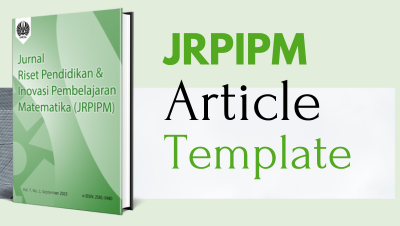Profile of Junior High School Students' Creative Thinking Abilities in Solving Open-Ended Problems on Number Patterns Material
DOI:
https://doi.org/10.26740/jrpipm.v8n1.p1-18Keywords:
creative thinking, open-ended, number patternsAbstract
Learning in the 21st century must be transformed from traditional to modern learning. This change is necessary to equip students with 21st-century skills, known as the 4Cs (Communication, Collaboration, Critical Thinking, Creativity). One of the skills that
students must master in the 21st century is creativity or creative thinking skills. Creative thinking skills are essential for all students to master at every level of education. This study aims to describe the profile of junior high school students' creative thinking skills in
solving open-ended problems in the number pattern material. Creative thinking is the ability to express original ideas, while open-ended questions are problems or questions that have many correct answers. Fluency, flexibility, and novelty are the indicators of creative thinking skills used. The method used in this study is to use a descriptive method
with a qualitative approach. Data collection in this study was carried out by giving a test about the ability to think creatively. After the creative thinking ability test, three subjects with high, medium, and low creative thinking abilities were selected for the interview. Then the results of the interviews will be analyzed using the time triangulation method.
The results of this study concluded that subjects with a high category of creative thinking abilities, subject fulfilled the three indicators of fluency, flexibility, and novelty. In subjects with the medium category of creative thinking ability, it was found that subjects
only met the indicators of fluency and flexibility. Meanwhile, subjects with low-category creative thinking abilities found that students did not meet the three indicators of creative thinking ability.
References
Arikunto, S. (2013). Prosedur Penelitian Suatu Pendekatan Praktik Penelitian : Suatu Pendekatan Praktik. In Jurnal Universitas Udayana. ISSN (Vol. 2302). Jakarta: PT. Rineka Cipta.
Firdaus, A., & Shodikin, A. (2022). Analisis Berpikir Kreatif Siswa dalam Pemecahan Soal Cerita pada Materi Pecahan Berdasarkan Jenis Kelamin. Jurnal Eksakta Pendidikan (JEP), 6(1), 61-68. doi: https://doi.org/10.24036/jep/vol6-iss1/646
Maulana, M. (2017). Konsep Dasar Matematika dan Pengembangan Kemampuan Berpikir Kritis-Kreatif. Sumedang: UPI Sumedang Press.
Munandar, U. (2009). Pengembangan Kreativitas Anak Berbakat. Jakarta: Rineka Cipta.
Silver, E. A. (1997). Fostering Creativity through Instruction Rich in Mathematical Problem Solving and Thinking in Problem Posing. Pittsburgh: USA.
Siswono, T. Y. E. (2018). Pembelajaran Matematika Berbasis Pengajuan dan Pemecahan Masalah. Bandung: PT Remaja Rosdakarya.
Sugiyono. (2013). Metode Penelitian Kuantitatif, Kualitatif dan R & D. Bandung: Alfabeta.
Suherman, E. (2003). Strategi Pembelajaran Matematika Kontemporer. Bandung: UPI JICA.
Wulandari, H. Y., Ekawati, R., & Shodikin, A. (2024). Exploring Creative Thinking Skill: How Do Students With Logic-Mathematic and Visual Spatial Intelligence Solve Contextual Mathematics Problems?. Jurnal Pendidikan Matematika (JUPITEK), 7(1), 22-32. doi: https://doi.org/10.30598/jupitekvol7iss1pp22-32
Downloads
Published
How to Cite
Issue
Section
 Abstract views: 364
,
Abstract views: 364
, PDF Downloads: 316
PDF Downloads: 316






